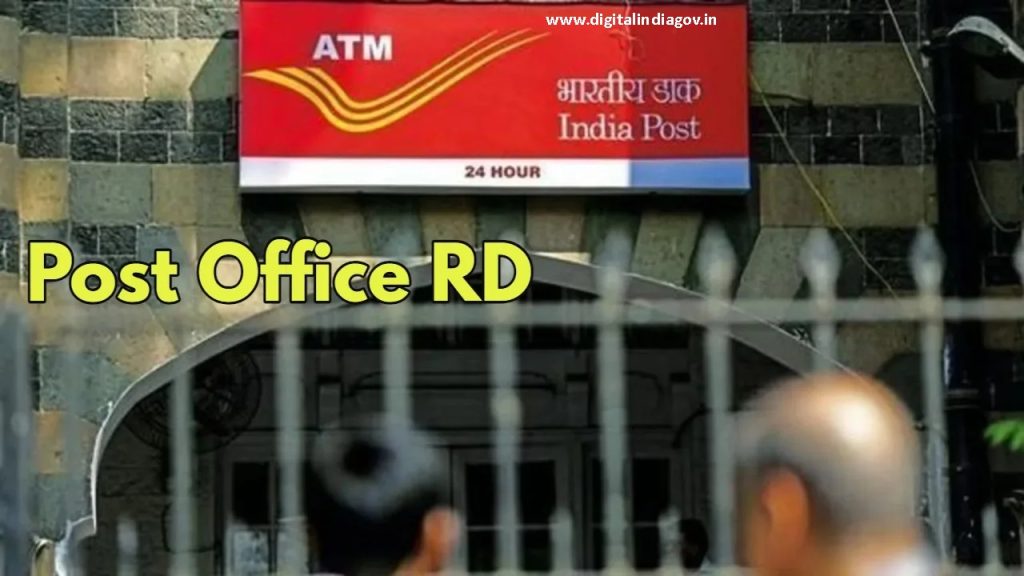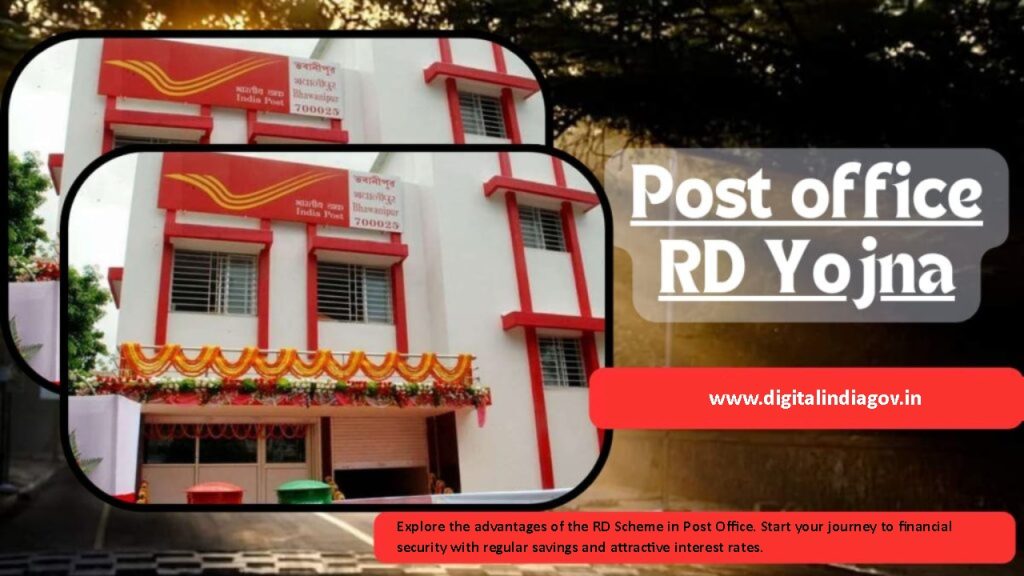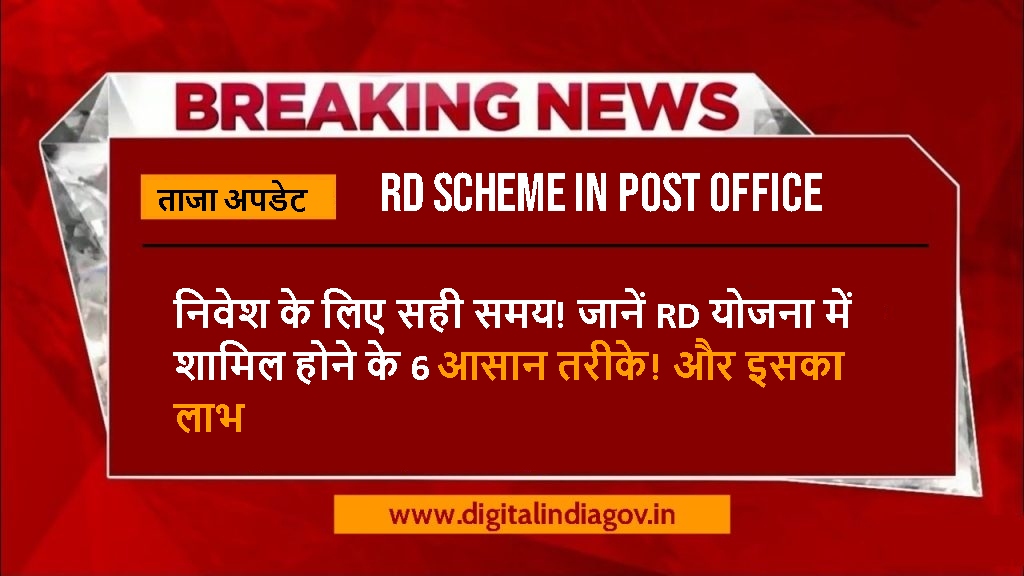RD Scheme in Post Office, Post offices are now your key to wise financial planning in addition to being a place to deliver mail. They provide a variety of financial services, such as life insurance and savings plans. Post office Recurring Deposits (RDs) stand out among these options. Compared to other long-term plans and standard fixed deposits, they are extremely popular. Post office RDs are the best option if you want to make prudent financial savings. Why are they unique? Well, the post office RD interest rates are primarily to blame. The RDs are quite appealing to anyone looking to increase their savings because they offer a nice 6.70% annual interest rate. Furthermore, your money keeps increasing until you take it out because interest is added up every three months.
With post office RDs, you can make your money work harder, so why cling to outdated methods of saving? They are the secret to getting more out of your money because of their excellent rates and simple growth.
Contents
Post Office Recurring Deposit Highlights
| Feature | Details |
| Interest Rate | 6.70% (As of January 2024) |
| Minimum Deposit | ₹100 per month |
| Tenure | 5 years |
| Maximum Deposit | No upper limit (Any amount in multiples of ₹10) |
| Missed Deposit Penalty | ₹1 for every ₹100 missed deposit |
| Compounded Frequency | Quarterly |
| Premature Withdrawal | Allowed |
| Loan Against RD Facility | Available |
| Nomination Facility | Available |

Also Read: Gold Investment Scheme, shaladarpanportalgov.com, yojanaforall.com, Onlinereferjobs
Comparison Of Interest Rates Of Various Post Office Savings Schemes
Let’s now evaluate the interest rates offered by the post office for different savings plans.
| Scheme | Interest Rate (Effective from 01/04/2023) | Minimum Investment | Maximum Investment | Eligibility | Tax Implications |
| Post Office Savings Account | 4% per annum (p.a.) | Rs. 500 | No limit | Resident Indians, minors, and adults | Tax-free interest on earnings up to Rs. 50,000 |
| Post Office Time Deposit Account (TD) | One-year – 6.9% p.a. | Rs. 1,000 | No limit | Resident Indians, minors, and adults | Tax benefits for up to 5 years under Section 80C on deposits. TDS deduction on interest above Rs. 40,000 p.a. |
| Post Office Monthly Income Scheme (MIS) | 7.4% per annum (payable monthly) | Rs. 1,000 | Single account: Rs. 9 lakh Joint account: Rs. 15 lakh | Resident Indians, minors, and adults | Taxable interest earnings. No deduction under Sec 80C. TDS deduction on interest exceeding Rs. 40,000 p.a. (Rs. 50,000 for senior citizens) |
| Senior Citizen Savings Scheme (SCSS) | 8.2% p.a. (Compounded Quarterly) | Rs. 1,000 | Maximum deposit limit: Rs. 30 lakh | Individuals aged > 60 years or 55-60 years for retired civilian or defense employees | Tax benefits under Section 80C. TDS deduction on interest exceeding Rs. 50,000 p.a. |
| 15-year Public Provident Fund Account (PPF) | 7.1% p.a. (Compounded annually) | Rs. 500 per financial year | Rs. 1.5 lakh per financial year | Resident Indians, minors, and adults | Tax rebate under Section 80C for deposits (up to Rs. 1.5 lakh p.a.), tax-free interest earnings |
| National Savings Certificates (NSC) | 7.7% p.a. (Compounded annually) | Rs. 1,000 | No limit | Resident Indians, minors, and adults | Tax rebate under Section 80C for deposits (up to Rs. 1.5 lakh p.a.) |
| Kisan Vikas Patra (KVP) | 7.5% p.a. (Compounded annually) | Rs. 1,000 | No limit | Resident Indians, minors, and adults | Interest is taxable, but the maturity amount is tax-free |
Features Of Post Office RD Scheme
This is what distinguishes it:
- RD’s post office interest rates are 6.70% annually, with quarterly compounding.
- A post office RD is in effect for five years at a time.
- A minimum monthly deposit of Rs. 10 is needed to open an RD account.
- A refund is given for advance deposits of at least six months.
- As long as it is in multiples of five, there is no upper restriction limit.
- It is acceptable to move Post Office RD accounts between post offices.
- A joint RD account can be opened by two people.
- Missed deposits are subject to a penalty of 5 paise for every Rs. 5.
How To Calculate Post Office RD Interest Rate?
This is a straightforward tutorial on figuring up the interest rate for a post office RD account:
Recognise the Formula: The following formula is used to determine returns from the post office RD account:
R[(1 + i)^n – 1] = M One minus (1 + i)^(-1/3)
Where –
M = Total Maturity Value
R = Monthly Deposit Amount
n = Duration in years
I am the offered interest rate.
Calculation Example: Suppose you want to deposit Rs. 10,000 per month for five years into a post office RD account with a 6.7% interest rate.
Here are the values –
R = Rs. 10,000
n = 5
i = 6.7
Apply The Formula: Inserting these values into the formula, we get –
[(1 + 6.7)^5 – 1] = 10000 M [1 minus (1 + 6.7)^(-1/3)]
M is equal to Rs. 7,13,659.
Therefore, you will receive Rs. 7,13,659 at maturity with a total deposit of Rs. 6,00,000. This shows that throughout the course of five years, an interest of Rs. 1,13,659 was earned.
Note: The computation is based on a calculator from a third party.
Using the interest rate offered and your monthly deposits, you can use this calculating approach to estimate the maturity value of your post office RD account.

Also Read: PMGKAY Scheme, Mobilenumbertrackeronline, indnewsupdates.com, ssorajasthanidlogin.com
Components Of The RD Interest Rates In Post Office 2024
Let’s dissect the elements that make post office RD interest rates:
- Duration: A post office RD’s tenure is set at five years, unlike bank recurrent deposits. An RD account is a medium-term investing option since many people choose it as a safety net for unanticipated situations in the near future. Account activity is required for the current five-year minimum tenure requirement for a post office RD. An extension clause permits an extra 5 years to be added to the RD account for individuals who choose to keep it open for more than 5 years, for a total duration of 10 years.
- Minimum and Maximum Deposits: One of the preferred investment options for generating good returns on monthly investments is a recurring deposit. In order to accommodate people who might be concerned about deposit quantities and interest rates, the minimum deposit has been purposefully kept low. The minimum monthly deposit is Rs. 10 and there is no upper limit on deposits, under post office RD regulations. Investors can donate any amount they can afford because deposit increments are allowed in multiples of Rs. 5.
Premature Withdrawal Of Post Office RD
Did you know that people can use their periodic deposits from the post office to cover unexpected expenses? What you should know about early withdrawal is as follows:
- Withdrawal Requirements: You have a year from the date of account opening to make a withdrawal from your Post Office RD. However, you can only take out 50% of the total amount of money that is accessible.
- Interest on Withdrawn Funds: The withdrawn sum is subject to a basic interest rate. The current rate at the moment of withdrawal is used to compute this interest.
- Repayment: A lump sum payment of the withdrawn amount plus any applicable interest is required. By doing this, the RD account is guaranteed to stay on course for the duration of its intended term.
People are better equipped to manage their Post Office RD and successfully meet their financial needs when they are aware of the premature withdrawal process.
Eligibility Of The Post Office RD Interest Rate
Make sure you meet the qualifying requirements before opening a post office RD account. This is who is eligible:
- Indian Nationals: Individuals or couples who are citizens of India and at least eighteen years old may open and manage an RD account at the Post Office.
- Children: Young people can begin saving money! Children under the age of ten may open an RD account, and their parents or legal guardians may operate the account on their behalf.
Documents Required To Open An RD Account
The following paperwork must be ready in order to open an RD account at the post office:
- Account Opening Form: Accurately fill out the post office account opening form by entering all required information.
- Two passport-sized photos of the account holder or holders should be brought.
- Address and Identity Proof: Verify that you have legitimate documents attesting to your address and identity. Aadhaar cards, passports, PAN cards, and declarations made on Forms 60 or 61 in accordance with the Income Tax Act of 1961 are among the accepted papers. You can also utilise a voter ID card, ration card, or driver’s license.
- Selection of Nominees: Select a representative for your RD account. In the event of unanticipated events, this is a crucial step to guarantee the seamless movement of funds.
- Signature of the Witness: Get a witness to sign the required paperwork.
How Does Taxation Apply To A Post Office RD Account
Post office RD accounts provide a combination of tax-related requirements and exemptions. What you should know is this:
- Tax Exemption Under Section 80C: Under Section 80C of the Income Tax Act, contributions made to a Post Office RD account are exempt from taxes. Under this clause, individuals are eligible to receive a tax exemption of up to Rs. 1.5 lakh annually.
- Interest Taxation: Although payments are tax-deductible, interest earned under the Post Office RD system is taxable. Depending on their income tax slab, people must pay taxes on the interest they earn.
- TDS Deduction on Interest: Tax Deducted at Source (TDS) is imposed if the interest earned on the RD account surpasses Rs. 10,000 within a fiscal year. While individuals without a PAN are taxed at a higher rate of 20%, those with an active PAN are entitled to a 10% TDS deduction rate.
People can efficiently manage their money and choose wisely when it comes to their Post Office RD investments by being aware of these tax ramifications.

Also Read: DDA Housing Scheme, digitizeindiagovin.com, Typingspeedtestonline, Nebsit Council
Faq’s
Q. What interest rate is available on RDs from the post office?
Ans: 6.7% annual interest is due on post office recurring deposits.
Q. What is a post office RD’s minimum deposit amount?
Ans: A post office RD requires a minimum deposit of Rs. 100.
Q. How can I avoid missing my post office RD instalment?
Ans: Each unsuccessful month will result in a default penalty of Rs. 1 for every Rs. 100.
Q. Can I get a loan on my RD at the post office?
Ans: Yes, after making 12 instalment deposits and maintaining the account open for a year, you are eligible to borrow up to 50% of the account’s remaining credit.
@PAY
